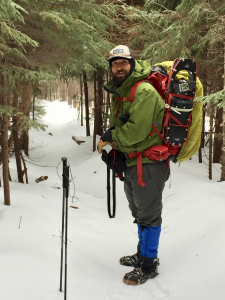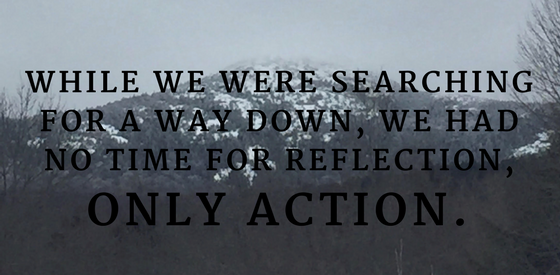“I wonder what sort of tale we’ve fallen into.”
—Sam as he approaches Mordor with Frodo in Tolkien’s Lord of the Ring
Since writing my last blog about the unanticipated dangers my son and I encountered on the summit of Cardigan Mountain, I have thought often since then about what happened and why I recall it so vividly.
When we passed the opened shelter at the base of Firescrew Mountain, we made our decision to forge on. We had no idea what that meant. We did know that daylight would soon fade to darkness and we knew we might be exposed to the full brunt of the winter wind as it gusted over the summits of the two mountains.

Arthur Kampmann, Cardigan Mountain 2017
The snow, the dark and the wind together conspired to confuse us with false signals as to the way forward, making us turn back time and again until we could hunt down a better way. But with all the forces of nature seemingly against us, we pushed on determined to find the cabin somewhere below the summit. It helped having one another as we made our way.
When Arthur finally called out that he had found the fire tower, there was no elation because the summit offered only danger. We could hardly hear one another over the roar of the wind, but we did not pause. We began a search for the trail that would take us to safety.
The cabin itself was dark and cold inside, but it was a refuge in the night and as soon as Arthur built a fire, the room began to warm. Now that we were secure, it was sobering to recall the conditions on the exposed summit of Cardigan. While we were searching for a way down, we had no time for reflection, only action. But now in the warmth of the cabin, I realized Arthur and I had just lived through the drama of a survival story.

John Eldridge wrote a short book on the centrality of story to the process of understanding the meaning of the life we live. Madeleine L’Engle has written, “All of life is a story.” Eldridge elaborates: “It goes far deeper than entertainment. Stories nourish us. They provide a kind of food that the soul craves. ‘Stories are equipment for living,’ says Hollywood screenwriting teacher Robert McKee. He believes that we go to the movies because we hope to find in someone else’s story something that will help us understand our own. We go (to movies) ‘to live in a fictional reality that illuminates our daily reality.’ Stories shed light on our lives.”

Myself, Cardigan Mountain 2017
Philip Yancey tells us that behind the human condition is an epic story that has fragmented into countless mysteries. He describes what he means by giving us GK Chesterton’s picture of the human story as “a sort of cosmic shipwreck.” Chesterton believes “a person’s search for meaning resembles a sailor who awakens from a deep sleep and discovers treasure strewn about, relics from a civilization he can barely remember. One by one he picks up the relics-gold coins, a compass, fine clothing-and tries to discern their meaning. Fallen humanity is in such a state. Good things on earth-the natural world, beauty, love joy-still bear traces of their original purposes, but lost of memory mars the image of God in us.”
To Chesterton and to me the ultimate version of this story is contained in the pages of the Old and New Testaments of the Holy Bible. The question for each one of us is to try to discern where we believe we fit into that larger biblical narrative as we discover patterns and context to the life we live here and now.



